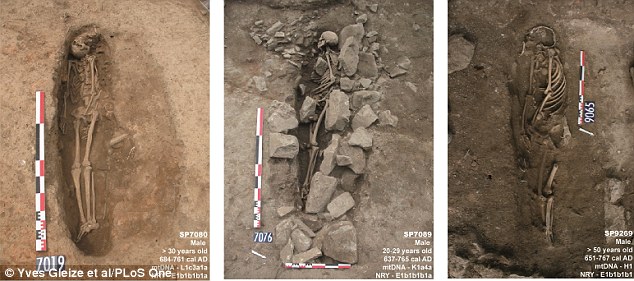A recent excavation and research project revealed something quite amazing. There were three skeletons found in medieval graves which dated back to the 8th century. These remains will now allow archaeologists and researchers to delve into how far Islam spread in its early days. Around 1,400 years ago, a small religious community, Islam, spread across the Middle East, eventually resulting in a massive empire.
How do archaeologists know these three skeletons are Islamic? They used genetic testing on these skeletons, which were found in Nimes, just in the south of France. That genetic testing revealed that the bodies belonged to Muslims from North Africa. Another indication that gave the archaeologists that idea is that the bodies had been buried in a way that suggested that they had followed Islamic rites. Their bodies and heads were orientated towards Mecca.

After looking further into the DNA evidence, it was revealed that their father’s families had come from North Africa. During this period, that would have been a huge part of the Umayyad Islamic empire. The Umayyad Empire is known to have spread as far as the south of Spain. However, researchers hadn’t known that it had also spread to France. These remains are the first pieces of evidence of the Muslim faith in that country during the Middle Ages.
One of the archaeologists at the French National Institute for Preventive Archaeological Research, Yves Gleize, said that the three skeletons may have been members of the Berbers tribes who had integrated into the Umayyad army. Another archaeologist on the team also said that the study they did is the first archaeo-anthropological testimony that Muslims were established in France.
The team added that the analysis done confirmed that the Berber origin of some of the first Muslim troops that had spread through Europe, suggesting that there was co-existence in some of the communities in Nimes who practiced Christian and Muslim funerary customs. There were no indications whether or not there was a partition of the funerary spaces. Gleize expressed that these relationships between communities must have been quite complex during that time period. This proves that the history books are far from being right about the relationships between the two religious groups.
As stated above, the three graves had been discovered in a medieval cemetery in the town of Nimes, which had originally been a Roman quarter. The bodies were found among 20 other graves. The only difference was that the three skeletons had been buried with a specific orientation; pointed towards Mecca, one of the most sacred sites in the Islamic faith.
Archaeologists noticed that the bodies had been wrapped before being put in a burial pit. After the bodies were put in the pit, they were covered by stone slabs or stones. The researchers used five bone fragments from the graves for radiocarbon dating to find that those people had lived between the 7th and 8th centuries AD. Before this grave was discovered, the oldest Islamic graves found in France were thought to date back to the 12th and 13th centuries AD.
Scholars did believe that Muslims could have begun moving into France far earlier than the first grave discovered. However, they were proven right by the ancient Islamic texts which actually mention Nimes between 719 and 752 AD. It was known before discovering these tombs that the Umayyads had conquered a majority of Septimania by 725 AD. But the new findings have suggested that they had integrated into that community far earlier than that.
One of the researchers said that the main thing that indicated this integration was that the graves were located right next to the Christian graves, rather than being segregated. Gleize believes that the Muslim troops had made alliances and agreements with the local communities around Nimes against the Franks.
He explained that many historians knew that there was a presence of Muslims in the region near Septimania, but finding these graves actually gives them physical proof. He added that the skeletons also provide proof that there was a community in the area who practiced Islam and that there was a co-existence between them and the Christian communities.
Other researchers on the team said that the presence of those members of the Berbers in France gives an insight into just how fast religious and political changes took place as Islam spread. The Berbers were indigenous North Africans who had integrated into the Muslim world as the Arab rulers spread out across the region.
Although there haven’t been many Muslim graves discovered, the researchers believe that the three skeletons provide enough evidence to prove that there was an establishment of a garrison or a long-term establishment in that region.